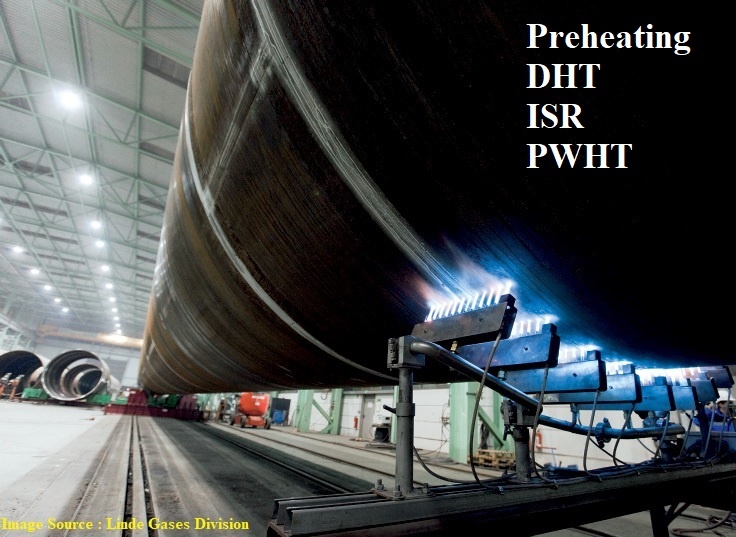Heat Treatment of welded joints
The intensity of the thermal cycles, which result in large residual stresses and/or weld metal and heat affected zone properties that differ radically from those of the parent material, determines the possibility of a weld defects. Failure might be sudden, occur over a short period of time, or present itself as a reduction in the structure’s performance.
Because thermal behavior is one of the primary reasons of weld failure, a number of potential remedies based on heat application exist. To ensure the integrity of the entire fabrication, the welding process must be controlled to minimise residual stresses. The metallurgical structures of the weld metal and heat affected zone are managed to provide properties that are comparable to the properties of the parent material utilised in the product design. Because of the necessity to regulate metallurgical changes and their corresponding mechanical properties, a series of heat treatment techniques are used before, during, and after welding.

Why heat treatment of welded joints?
- To avoid / reduce / minimize detrimental effects of weld thermal cycle which has high heating and cooling rates
- Temperatures and cooling rates are carefully controlled based on chemical composition to create the various microstructures associated with a required set of mechanical properties. and to create desired qualities like as tensile strength, ductility, notch toughness, or creep resistance after welding.
Above reasons can be explained in mainly two aspects are of course inter-related with each other.
Mechanical aspect
The welding procedure for metals, in the vast majority of cases, fuses two components together. A source of heat provided by a number of welding methods based on an electric arc, electrical resistance, or a flame increases the temperature of the surfaces to be bonded locally to melting point.
To form the welded joint, small or thin components may be fused together autogenously, but generally a filler material is employed. The process energy melts the consumable into a localised molten pool, fusing it to the component surface and/or previously deposited weld metal.
The components are heated non-uniformly and then cooled non-uniformly as the molten pool moves down the joint axis. Due to localised thermal cycle, adjacent material components try to expand and contract by different amounts. High stresses combined with joint constraint and inadequate ductility can cause to cracking failure. The origins of residual strains caused by the welding process’ heat cycles. They are tensile in nature. Compressive stresses will be produced elsewhere to provide a self-balancing state, as any stress system must be in equilibrium to remain stable.
It’s important to remember that tensile stresses can be extremely high, often exceeding yield point magnitude. In summary, thermal cycle has adverse effects on residual stresses hence the mechanical properties which leads to weld defects, which are undesirable. So this detrimental effect should be minimized by heat treatment.
Metallurgical Aspect
Weld metal deposition in a molten pool, localised melting of the component joint faces, and subsequent rapid cooling all have metallurgical implications that influence the microstructure of these locations. This leads to metastable phases in weld metal region.
Cooling after welding can be relatively rapid. In the region of parent metal at the fusion face heated to its melting point, metallurgical solidification (epitaxial solidification) takes place. The rapid cooling results in this region having a different metastable phase metallurgical structure and hence mechanical and corrosion properties which differ from the bulk parent material.
Example covering both aspects:
Martensite formation due to rapid cooling rate in weldment, which is harder and brittle nature. Also due to its displacive transformation (diffusion less) subsequent volume changes lead to residual stresses. Therefore, this phase has to be heat treated to reduce its adverse effects and to get desired properties.
Not all welded joints require heat treatment. Why?
It is possible to fabricate welded structures without any heat treatment. It is also possible that heat treatment has a harmful rather than beneficial effect. Since it is time consuming and costly affair, wherever it is not required for material referring to fabrication code, Heat Treatment shall be avoided.
Detailed requirements that which material require Preheat, PWHT, and their time are mentioned in their fabrication codes such as ASME Sec VIII, EN13445, BS PD 5500.
Example: Preheat is required for Ferritic Steels. But not required for Austenitic stainless steel.
Critical Treatments in welded joints
- Preheat
- Post-heat or De-Hydrogenation Treatment (DHT) (during fabrication)
- Outgassing or Hydrogen bake-out (repair work of part in service)
- Postweld heat treatment (PWHT)
- Intermediate Stress Relieving (ISR)
One thing should be clear that, in some fabrication standards heat treatment type is different. Terminology differs from one code to another and the philosophy differs as well. Therefore, it depends on material and respective fabrication code.
Click on link to learn more about them in detail, with their effects on various materials, and requirements of relevant fabrication standards (ASME Sec VIII, EN13445, BS PD 5500).
References
- D Croft, “Heat Treatment of Welded Steel Structures”, Woodhead Publishing in welding, Elsevier, 1996
- Heat Treatment of Welded Joints by TWI
